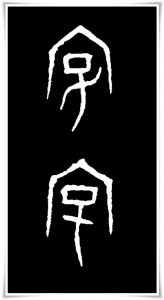
1. Meaning:
character, letter, section of village, word, courtesy name
2. Readings:
- Kunyomi (訓読み): あざ, あざな, -な
- Onyomi (音読み): ジ
- Japanese names: does not appear in Japanese names.
- Chinese reading: zì
3. Etymology
字 belongs to the category of characters known as 会意文字 (かいいもじ, kaii moji, i.e. a set of characters which are a combination of two or more pictographs, or characters whose meaning is based upon an abstract concept).
字 is composed of two characters, 子 (し, shi, “child”) and 宀 (べん, ben, i.e. “roof” radical, found in Chinese characters). 宀 in the character 字 symbolizes a family shrine or temple. According to ancient custom, the name of a newborn child was carved onto the walls of a shrine, reconfirming the “completeness” of a given family as a whole. At the same time, the child was given a name. Right up to the present, one of the meanings of the character 字 is “courtesy name”.
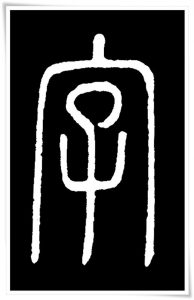
In “Explaining Simple (Characters) and Analyzing Compound Characters” (說文解字, pinyin: Shūowén Jiězì) from the 2nd century C.E., compiled by Xu Shen (許慎, pinyin: Xǔ Shèn, ca. 58 C.E. – ca. 147 C.E.), a philologist of the Han dynasty (漢朝, pinyin: Hàn Cháo, 206 B.C. – 220 C.E.), it is written that the meaning of 字 was associated with human reproduction and the raising of children.
There were many characters whose structure was associated with various ancient Chinese customs, etiquettes, and rituals connected to the above meaning of 字. For instance, the etymology of the character 産 is associated with the ritual of a newborn child’s purification ceremony that included tattooing the infant’s forehead. Similarly, the character 名 (めい, mei, i.e. “name”) is associated with a sacrificial ritual (animal sacrifice) which was performed at a designated time after the child’s birth.
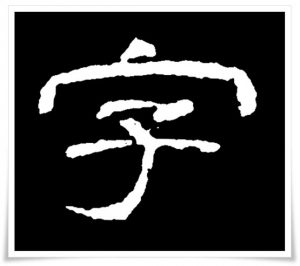
Confirmation of the association of the ancient meaning of the character 字 can be found in one of the Confucian classics, titled Li Ji (礼記, pinyin: Lǐ jì), which is the 5th part of the Wu Jing (五經, pinyin: Wǔ Jīng), written during the reign of the Emperor Wu of Han (漢武帝, pinyin: Hànwǔdì, 156 B.C. – 87 B.C.), Han dynasty. There one reads that a crowning ceremony was combined with the assuming of a courtesy name (here: royal title name). Further, in the Commentaries to the Spring and Autumn Annals (春秋公羊伝, pinyin: Chūnqiū Gōngyángchuàn), a classic Chinese history book from the late 5th century B.C., one reads that the courtesy name (字) giving ceremony was organised for children who became 15 , which was, at the time, considered the age of adulthood.
As noted above, the courtesy name usually consisted of two characters. One of them was 子, and the other described the character of the person bearing the given name. It is possible that from this instance the modern meaning of the character 字 derives, i.e. “a (Chinese) character”.
4. Selected historical forms of 字.
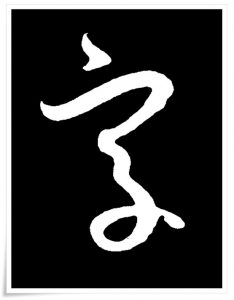
Figure 1. Oracle bone script (甲骨文, こうこつぶん, kōkotsubun) form of the character 字, Shang dynasty (商朝, pinyin: Shāng Cháo, 1600 – 1046 B.C.).
Figure 2. Small Seal script (小篆, しょうてん, shōten) form of the character 字 found in the book “Explaining Simple (Characters) and Analyzing Compound Characters” (說文解字, pinyin: Shūowén Jiězì) from the 2nd century C.E., compiled by Xu Shen (許慎, pinyin: Xǔ Shèn, ca. 58 C.E. – ca. 147 C.E.), a philologist of the Han dynasty (漢朝, pinyin: Hàn Cháo, 206 B.C. – 220 C.E.), under the seal script section (篆書, てんしょ, tensho) entitled Shuowen Zhuanwen (説文篆文, pinyin: Shuōwén zhuàn wén).
Figure 3. Ink rubbing of the clerical script (隷書, れいしょ, reisho) form of the character 字, taken from the stele Yi Ying bei (乙瑛碑, pinyin: Yǐ Yīng bēi) erected in 153 C.E., the Eastern Han dynasty (東漢, pinyin: Dōnghàn, 25 – 220 C.E.). The Yi ying bei stele is an example of mature clerical script, also referred to as happun rei (八分隷, はっぷんれい, lit. “eight parts slave {script}”).

Figure 4. A cursive script (草書, そうしょ, sōsho) form of the character 字 found in the preface to the famous Treatise on Calligraphy (書譜, pinyin: Shū pǔ) by Sun Guoting (孫過庭, pinyin: Sūn Guòtíng, 648 – 703 C.E.), a calligrapher of the Tang dynasty (唐朝, pinyin: Táng Cháo, 618 – 907 C.E.).
Figure 5. Standard script (楷書, かいしょ, kaisho) form of the character 字, from the stele Yan Qinli bei (顔勤禮碑, pinyin: Yán Qínlǐ bēi) by Yan Zhenqing (顔真卿, pinyin: Yán Zhēnqīng, 709 – 785) of the Tang Dynasty (唐朝, pinyin: Táng Cháo, 618 – 907 C.E.).
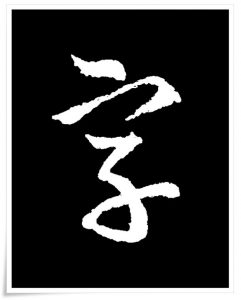
Figure 6. Semi-cursive (行書, ぎょうしょ, gyōsho) form of the character 字 found in one of the letters compiled under the name Shiqi tie (十七帖, pinyin: Shíqī tiè), attributed to Wang Xizhi (王羲之, pinyin: Wáng Xīzhī, 303 – 361 C.E.) of the Jin dynasty (晉朝, pinyin: Jìn Cháo, 265 – 420 C.E.). Although the letters in that compilation were written in cursive script (草書, そうしょ, sōsho), this particular form follows more closely the semi-cursive hand.
5. Useful phrases
- 四字熟語 (よじじゅくご, yoji jukugo) – an idiom composed of four Chinese characters
- 文字 (もじ, moji) – charcters, letters
- 漢字 (かんじ, kanji) – Chinese character(s)
- 字典 (じてん, jiten) –Chinese characters dictionary
- 大字 (おおあざ, ooaza) – larger section (of a village)
